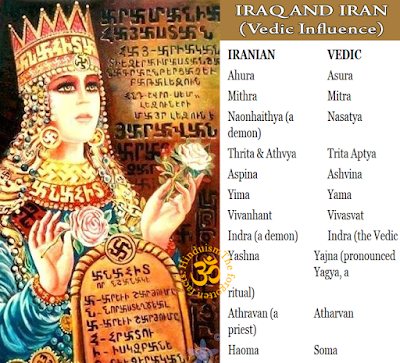IRAQ AND IRAN (Vedic Influence)
By Stephen Knapp
The names Iraq and Iran are derived from Sanskrit. The common root is “Ir,” such as found in the Irawati River in Myanmar (Burma). The name “Iranam” in Sanskrit, from which the name Iran is derived, applies to salty and barren lands. This was the name that was given to the region by the Sanskrit-speaking Kshatriya rulers or administrators. The capital of Iraq, Baghdad, also has a name based on Sanskrit, Bhagwad or Bhagwan Nagar, which is referring to Nagar (a city) dedicated to Bhagwan (Lord Krishna). It was abbreviated to Baghdad, meaning simply the “City of God.”
This also means that this was not the first Muslim city, said to have been built by Caliph Al-Mansur in one year, 762-63 CE, but was one of the first captured Vedic centers. Otherwise, it would not have had a name derived from Sanskrit. Furthermore, it was a well-planned city, which would have taken much longer than a year to build. This is also an indication of the typical falsification or suppression of real history that forceful religions use to hide whatever advancements existed in the previous culture.
Kurdisthan is a part of Iraq and is also a Sanskrit name. The Kurdi language and customs still bear unmistakable traces and the stamp of their Sanskrit and Indian origin.
An interesting thing is that the royal family of Iran, the Pehlavis, have their roots in the Vedic Kshatriya tradition. The name Pehlavi appears first in the Ramayana episode in which Vishvamitra attempts to drive away Vashista’s sacred cow. The title “Shah” is also a Vedic name and is also a common Hindu surname. The Hindu king of Nepal also bears the title of “Shah.” The Kshatriya king of Gwalior deposed by the Muslims was Ram Shah. The wealthy patriot who turned over his wealth to Rana Pratap to help defend India was Bhama Shah. Therefore, the title “Shah” in Iran is simply a reminder of the Indian Kshatriya tradition that once ruled the area of Iran. In fact, when Iran started to come under attack by the Islamic invasions, many of the common people ran away to India. Histories also record that the royal family at the time also considered leaving Iran to seek shelter in India. So, the very fact that the people and the ruler of Iran thought of coming to India during the Islamic raids proves that they were Hindus, part of the Vedic culture.
The Rig-veda, being the most ancient scripture, and its language being Sanskrit, provides evidence that Sanskrit is the great ancestor of all known languages. Persian is also, therefore, a descendant dialect of Sanskrit. For example, many towns in Iran have Sanskrit names. The birth place of Omar Khayyam, a well-known Persian poet, is Nishapur, which is a pure Sanskrit name. Indian troops stationed in West Asia during World War I and II have reported seeing temples of Indian deities like Ganesh and Shankar (Shiva) in ruins in remote desolate areas of Iran, Afghanistan, and other countries. Iranian mythology also has links with ancient Vedic lore.
One of the more interesting pieces of evidence is that the Iranians also knew of Lord Rama, as noted by Koenraad Elst in his book, Indigenous Indians: Agastya to Ambedkar (Voice of India, New Delhi, 1993). He writes that according to Ghosh, the name of Rama appears in the earliest portion of the Avesta as god of peace, associated with Vayu, the wind god. This mention of Vayu is likely to mean Hanuman, Rama’s close devotee and associate, the son of Vayu. Rama’s guru, Vasistha is also mentioned as Vahista, who has his own Gatha dedicated to him, Vahishte-Ishti-Gatha. This was before the Zoroastrian revolution. Also, many of the Iranian rituals were similar to those of the Vedic customs, such as the wearing of the sacred thread. So this reflects a migration of the early Iranian people out of India from many years ago, no later than 1900 or 1800 BCE.
Further evidence is that the main demon in the Avesta is Angra Mainyu, the Rigvedic Angira and Manyu. The Angiras are seven prominent families of rishis in the Rig-veda, while Manyu is Indra in a destructive form in the Rig-veda (10.83 & 10.84). Names of Iranian gods were similar to the Vedic, such as in the picture.



Comments
Post a Comment